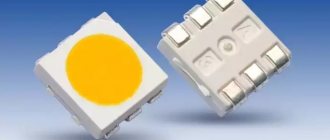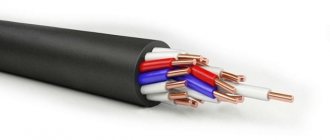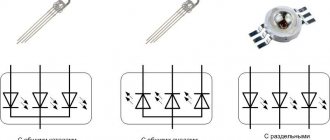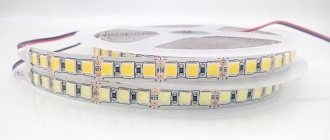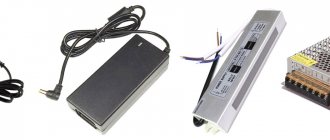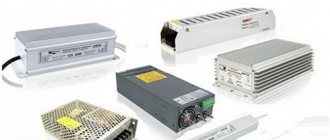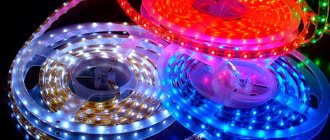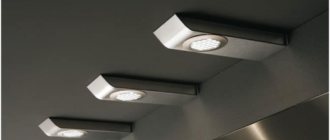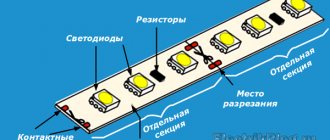LED strip is one of the types of LED lamps, made in the form of a flexible plastic base with an adhesive layer on the back side and LEDs located on it.
It is used for decorative interior lighting, and also as an alternative to the main lighting source. Supplied in plastic spools. The length of the reel is 5 meters. The tape is a single copper board on which resistors and LEDs are located. These five meters consist of individual segments of 5 cm each.
For example, an SMD3528 tape has 1 resistor and 3 LEDs on such a segment. The SMD5050 strip has its own resistor for each LED. Along the edges of the segment there are cut lines and places for soldering. Thus, if necessary, the tape can be shortened only by a length that is a multiple of the segment length.
The copper base of the LED strip is actually the same wires, only in a flat design. Their cross-section is designed for a current capable of powering an area of no more than 5 m. Extending the tape yourself may lead to its failure.
Types of LED strips
LED strips come in several types:
- monochrome or monochrome
- colored or RGB=Red-Green-Blue (red-blue-green)
You can distinguish one-color from RGB by the number of soldered wires. There are only two of them on monochrome, and four on color.
At the same time, to connect a single-color strip, you only need a power supply, and for an RGB strip, a controller is also required.
- open
- protected from moisture
They are also divided according to the size of the LEDs and the method of their application. The most common are:
- SMD3528
- SMD5050
Less popular:
- SMD2835
- SMD5630 (5730)
What is SMD and how does it stand for? SMD from English Surface Mounted Device - surface mount device. That is, the LED is soldered to the substrate on top.
The numbers after SMD indicate the size of the LED in millimeters - its length and width.
How to determine the power of the power source for an LED strip
Using the data obtained from the markings, you can find out what the power of the power supply unit (PSU) for the tape should be. This is the name of a device that helps transform mains voltage (220 V) into operating voltage (12 or 24 V). The power supply is necessary for the correct operation of low-voltage diode light emitters.
So, in order to choose the right power source, it is not necessary to study the catalog or consult with specialists. All the information necessary for this can be read on the packaging. For the calculation, two indicators are needed: the required length of the light emitter and the power of its meter segment. The first number is known to the buyer, and the second will be indicated by the information on the packaging of the lighting device. Multiply the power of the meter by the length of the tape. Add another 30% to the resulting value for the margin. This way you will get the power of a power source that is suitable for a given section of LED strip.
SMD 3528 tape
This type has small LEDs 3.5mm * 2.8mm. The brightness of such a diode is only 4-6 lumens. Tape width 8mm. This type is used exclusively for decorative lighting.
It does not blind your eyes and, due to its low power, allows you to save on the purchase of powerful power supplies.
SMD3528 is available in monochrome colors and is not able to change its color during operation.
SMD 5050 tape
SMD5050 has LEDs measuring 5mm by 5mm. Such LEDs can already replace the main lighting, since the power of just one element here is 11-25 lumens.
This will give a luminous flux equal to a 60 watt incandescent light bulb. Actually, the consumption of SMD5050 is only 15 W. Tape width - 10mm.
It is about 3 times brighter than SMD3528. One of its main advantages is the ability to change colors under the control of an RGB controller.
SMD 2835 tape
SMD2835 produces about 50 lumens per chip. It has a high price. Width - 8mm.
High light output also has a negative side - heating the surface. It is prohibited to use such tape without good heat dissipation.
Use an aluminum profile for it, preferably with a matte screen. It will diffuse the light, smoothing out the glare effect.
LEDs 2835 and 3528 are very similar to each other, how can you quickly distinguish them? The cheap 3528 chip is tall, while the expensive and bright SMD 2835 has a low profile for better cooling and heat dissipation.
Having trouble choosing LED lights?
We will prepare a full calculation of the cost, necessary equipment and 3D visualization for lighting your facility. It’s FREE - even before purchasing and concluding a contract, you can find out: “How many and what kind of lamps are suitable?”, “How much will it cost?”, “What will it look like?”
and even “How long will the counter wind up?” More about this
Side glow tapes
Side glow strips use cylindrical LEDs that are soldered to the end of the board.
Side glow tape
The end arrangement of the LEDs changes the direction of the light - the LEDs shine along the illuminated plane. Such tapes are often used to backlight plasma screens and monitors, as well as in advertising structures.
SMD tape 5630 (5730)
The most powerful chip is 5630 (5730). It has a light output of 60 lumens.
It is even more demanding when it comes to cooling. It is mainly used for illuminating expensive interiors and in the windows of inexpensive shops and boutiques.
Comparison of technical characteristics of LED strips SMD3528, 5050, 5630, 5730 summarized in one table:
Main conclusions
The first condition is to choose a high-quality LED strip - it will be 30-50% brighter than a cheap one and will last (at least) 5 years. When choosing a cheap product, it is difficult to calculate the parameters of the power supply, since the parameters declared by the manufacturer most often do not correspond to the real ones. If the lighting system is completely changed, it is advisable to entrust the calculations to a specialist.
Previous
LEDsT6 or U2 LED, which is better in terms of technical characteristics
Next
LEDsTypes and diagram of a device for testing LEDs
Power and brightness of the tape
Everything is simple here, the more LEDs mounted on the strip and the larger they are, the greater its power. The lowest power is SMD 3528 with 60 diodes. Its power is only 4.8W.
The brightness of an LED strip is proportional to its power. The more powerful it is, the brighter it will shine. Just don’t confuse the dependence on quantity here, and always pay attention to the size of the LEDs themselves.
A strip with 30 elements can shine much brighter than one with 60.
How to calculate the light output of a diode strip
To compare the brightness of a flexible diode illuminator with a similar characteristic of an incandescent lamp, you need to know four parameters:
- tape length;
- total number of LEDs;
- luminous flux (F);
- power indicator (P).
For 3528 chips, the placement density of which is 60 pieces per meter, F reaches 300 lm, P – 4.8 W/m.
Let's calculate the light output of a meter of diode strip, the markings of which were deciphered above. To do this, we determine the quotient of the values of F and P. To calculate the first parameter, you need to know the luminous flux of one LED. For 3528 chips it is 5 lm, and for 60 pieces it is 300 lm. We calculate the light output: 300:4.8=62.5 (lm/W).
For comparison: the light output of an incandescent lamp does not exceed 12-13 lm/W. This means that 1 m of LED strip with a power of 4.8 W shines as brightly as a traditional 25-watt strip. A 100 W lamp corresponds to a 4-meter piece of tape.
Flexible diode strip is a reliable and durable light source that turns out to be the most effective in many situations. Especially if you choose a lighting device wisely, taking into account all the data displayed in its labeling.
Degree of protection
The degree of protection of the tape is indicated by two Latin letters - “IP” and two numbers after them.
- tapes without protection - IP20
It is not protected from moisture, splashes and is very poorly protected from mechanical influences. Soldering points, contacts, etc. are exposed. Some manufacturers specify IP33 in their documents, but this can also be attributed to products without protection.
If moisture gets on such a tape, a short circuit may occur and it will burn out.
- tapes with IP65 or IP54 protection
A protective compound is applied to it on the upper side. Among experts it is called silicone tape. In fact, it is not silicone, but an epoxy coating.
This LED strip is afraid of frost, because its protection at subzero temperatures simply hardens and becomes hard and brittle.
- tapes with IP67 protection
This is already a completely sealed product. This tape can even be installed outdoors. It is placed in a silicone case and is not afraid of moisture and rain.
- maximum protection IP68
This tape is placed in a U-shaped silicone profile and filled with epoxy compound on top. It can even withstand being placed in water. Often used for lighting in fountains or in the bathroom.
Having familiarized yourself with all the characteristics, the next time you go to the store, when you ask the seller: “What kind of LED strip do you need?” you must answer boldly and knowledgeably:
“I need an SMD 5050 LED strip with 60 diodes, with a degree of protection of IP65 and so that its luminous flux is at least 1200 lumens.”
How to choose an LED strip: power, type and number of LEDs, color, width and IP strip.
How to choose an LED strip and not get confused about watts, volts, amperes and IP? In the last article, we told you how to choose the right LED strip to illuminate your home or apartment. Namely, we learned 3 important points when choosing a tape and figured out the supply voltage required for the tape to operate.
Let's continue choosing LED strip? Today we will study in more detail such characteristics as: strip power, luminous flux, LED type, strip width, color - and learn how not to get confused in all this and determine the indicators you need.
Belt power
One of the main characteristics when choosing an LED strip is power consumption, which is directly related to the luminous flux. Simply put, the higher the power of the tape, the brighter it is.
Power is indicated for a 1 meter piece of tape. Thanks to this, it is more convenient to calculate the final electricity consumption and select a power supply.
LED strips with a power consumption of 4.8 W/m, 9.6 W/m are considered low-power. Their luminous flux is small; as a rule, they are not used as the main light source, but only as decorative lighting. Low power leads to low heating, which has a positive effect on increasing service life.
LED strips with a power of 14.4 W/m and higher have a more powerful luminous flux. But they also heat up more, so you need to use an aluminum profile with them - this will ensure heat dissipation and prevent degradation of the LEDs.
Light flow
At the everyday level, we can say that the luminous flux reflects the brightness of the tape. Luminous flux (measured in lumens) is indicated per 1 meter of tape. This value directly depends on the power consumption (W/m) of the LED strip, as well as the luminous flux of each LED, the number of LEDs per 1 meter and the type of LED.
LED type
LEDs on strips have different markings, for example, SMD3528, SMD5050, SMD2835, SMD3014. This is deciphered as follows. SMD is an abbreviation for surface mounted device, which in English means “surface-mounted device.” And the number is the size of the diode.
For example, the designation SMD 3528 means a diode with a size of 3.5 x 2.8 mm, and SMD 5050, respectively, with a size of 5 x 5 mm.
Number of LEDs
Another parameter by which LED strips differ is the number of LEDs. The density of their location is indicated per 1 meter. Accordingly, the more of them, the denser the flow of light, and the higher the brightness of the tape, all other things being equal. LEDs can be in one or two rows.
There are tapes with 30 diodes per meter; they are designated 30d/m. 60d/m is 60 diodes per meter. This is followed by such options as 120d/m, 168d/m and 240d/m.
Tape width
Depending on the size of the LED chip, the width of the strip itself on which it is placed also varies. This is due to the design of the substrate's current-carrying circuitry, which supplies current to the LED.
The substrate widths are 8 mm, 10 mm, 12 mm, 20 mm and 30 mm. This is an important point when choosing a tape, because depending on this, the size of the aluminum profile is selected (more about it below).
IP protection type
The dust and moisture protection class is a very important parameter for the safe and durable service of the tape.
IP20 class LED strips are designed for use in dry rooms. This open tape has minimal protection from dust and is not at all protected from moisture.
LED strips with dust and moisture protection class IP65 are not so afraid of dust and water; they can be used in open spaces and in damp rooms. But it should be taken into account that the tape is protected only from the side where the LEDs are located, and it cannot be lowered into water.
But LED strips with dust and moisture protection class IP67 are completely covered in a protective transparent casing and can withstand immersion in water up to 1 meter. True, here it is necessary to take into account the immersion time and the composition of the water. Leaving the tape for a long time in an aquatic environment where salt or foreign aggressive impurities are present can lead to its failure.
You can read more about the protection class in our article.
Color selection and color temperature
And finally, no less important aesthetic point is the color with which the ribbon glows. It can be white, red, blue and so on. The most popular color, of course, is white, which, in turn, is divided into warm and cold.
Warm white corresponds to a temperature of 3000 K. Typically, it is a warm yellowish shade of sunlight. An LED strip with this color temperature provides a soft light that soothes and allows you to relax. Therefore, it will be more appropriate when used in residential areas, for example, in the bedroom.
But, since this color is conducive to relaxation, it is not recommended for use in work areas, production facilities, offices and public places.
Cool white corresponds to a temperature of 6500 K. It is used in places where concentration and clear perception of details are required; Well suited for warehouses and work areas, clinics and hospitals.
This color of light is not recommended for lighting bedrooms, as it makes it difficult to relax. Cool white is also not recommended for mirror lighting - in such light the skin will look unnatural.
Tapes with other color temperatures may also be available, for example, 4000 and 5000 K. Light 4000 K is associated with daylight white light; It is suitable for interior lighting in living rooms and hallways, as well as for illuminating mirrors and bathrooms. It is also irreplaceable as kitchen lighting.
A color temperature of 5000 K corresponds to sunlight at noon. Pure white color without shades allows you to increase concentration and therefore is often used in offices and in production, and is used as interior lighting.
Read more about color temperature and recommendations for choosing it in this article
Today we got acquainted with such characteristics as tape power, luminous flux, LED type, tape width, color - and learned how not to get confused in all this.
In the next article, we will decide on the profile, learn about the installation features depending on the length of the tape, and get recommendations from a specialist.
Differences between cheap and expensive LED strips
The most “blurred” characteristic, but the most important for you, is the quality class of the tape. Why do the same copies with the same number of LEDs, power, and the same degree of moisture protection cost completely different money?
How to distinguish a good tape from a poor one and what is the difference? To understand this, you need to know what the LED strip consists of.
Its three main components:
- substrate or flexible printed circuit board
- the LEDs themselves
- resistors
Protection from moisture and dust
The presence of an additional layer affects the width and dimensions of the LED device. Predetermines installation in apartments, rooms with high humidity and even in flooded environments. The marking in this case is indicated by IP, followed by numbers with the protection class. Starting from IP 20 and ending with 65, models with full protection are presented, the possibility of use in swimming pools or aquariums, for home use. The lower the indicator, the more likely it is that there is no protection from humidity and dust. Thin LED strips do not have a safety class, so they are only suitable for domestic use. They can be used to decorate furniture, create small items and structures. For bathrooms, protection class IP44-54 is suitable if the surface is not splashed. The disadvantage of tightness is that the structure cools slowly. This affects the degradation of diodes and their service life. Using a light source in a hot but humid room, the owner receives weak radiation and the need for constant replacement. Recommended operating requirements are indicated on the packaging of the LED device.
Substrate
Despite the similarity, standard-class tapes and premium tapes differ in everything, starting with the backing. In the premium version, it contains much more copper. This tape is simply thicker.
Due to this, its current-conducting ability is much higher, plus it removes heat faster. Unfortunately, you can’t feel this with your hands, but an electronic caliper or micrometer will help determine the difference in the thickness of a cheap and expensive tape.
How the LED strip works and how it works
The principle of operation of the strip, like any LED lamp, is based on the ability of semiconductor pn junctions to emit when current passes. The frequency of radiation can lie in the infrared, visible or ultraviolet region. In this way, you can get a monochrome glow, but not white, which is a mixture of colors in the visible part of the spectrum. A breakthrough was the development of LEDs, in which the light-emitting component was a coating of phosphor substance. Its glow is initiated by emission from the pn junction, which does not have to be visible (usually UV light). This dramatically expanded the scope of application of LED lamps and this is where their triumphal spread began.
The popularity of flexible lamps is based on the possibilities of their application. Such a device can be mounted in a variety of places with any configuration. The installation of an LED strip is not difficult. Groups of LEDs with quenching resistors or with addressable microcircuits are applied to a flexible base of varying thickness. Along the canvas there are power buses, ending with contact pads on both sides. Many manufacturers apply an adhesive layer to the other side to simplify installation.
Various types of flexible luminaires with cut lines.
The canvas can be cut in the specified places, forming sections of the required length. Group diagrams, types of LEDs and resistor values determine the characteristics of the lamp and its scope of application.
LED difference
The LED itself consists of a housing in which emitting crystal chips are placed. The whole thing is filled with compound on top. The chips in cheap and expensive tapes are different.
What are the differences?
- in size
In inexpensive tapes, they are smaller in size and, accordingly, produce a lower luminous flux.
- conductive thread material
For high-quality ribbons they are gold. In standard versions they are made of alloys. Over time, under the influence of a phosphor or compound, the alloy threads are destroyed. Therefore, the service life of the LED itself is shorter.
- quality of phosphor filling
For the elite class, it has less impact on the chips themselves and their contact does not affect the service life of the LED.
- difference in chips
The so-called binning. This is when neighboring LEDs, due to different crystals, can shine with different fluxes and shades.
How can you see all this clearly in the store? Unfortunately, this cannot be done visually without applying voltage. But by turning on the tapes in parallel, one next to the other, you can see the difference.
The premium LED will appear to be slightly larger. Actually this is not true. Both may have SMD3528, but the high-quality version will simply have a larger chip. Because of this, this impression is created.
But it’s best to look not at the LEDs themselves, but at the surface illuminated by them. LEDs from different companies may have different scattering angles (according to the standard it should be 120 degrees). A chip with a smaller angle (90-100 degrees) will visually seem much brighter to you, although in fact this will not be the case.
Adhesive base
All tapes have an adhesive backing on the back. For Premium it is Scotch 3M. Moreover, there should be not only one 3M inscription, but also markings in the form of separate numbers.
However, no matter how high-quality it is, over time this tape also comes off. Imagine if you have all this stuff hidden behind a suspended ceiling?
Therefore, professionals advise using heat-conducting glue for gluing LED strips or additionally supporting it at several points with small zip ties.
